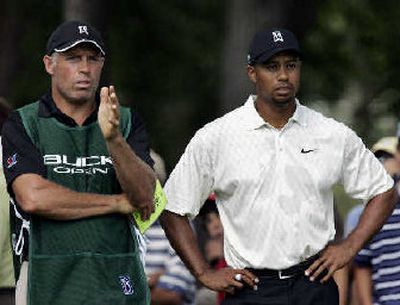Woods, Williams are special team

Their relationship transcends a player and his caddie.
That much was clear from an emotional embrace on the 18th green at Royal Liverpool, when Tiger Woods crumbled into the arms of Steve Williams after winning the British Open, staining his black shirt with tears the caddie knew were inevitable.
Williams was at his side when Woods buried his father in May. Two weeks earlier, Woods had flown halfway around the world to be the best man when Williams got married in New Zealand.
This wasn’t what the Kiwi caddie imagined seven years ago when he started working for the world’s No. 1 player.
“In my mind, it was important to do the job, and not get too friendly with him,” Williams said during a rain delay at the Buick Open, which Woods won for his 50th title on the PGA Tour, 43 of those with Williams on the bag.
“For some reason, he and I just clicked. It wasn’t intentional. It’s just the way it worked out.”
That hug at Hoylake can be traced to Medinah and the 1999 PGA Championship, a course outside Chicago that holds special memories for Williams and where he returns next week for another PGA Championship.
It was there, on the 17th green in the final round, when the caddie felt he finally had earned the trust of his player.
They had been together for only five months and 10 tournaments, three of them victories, none in a major. Woods had lost his No. 1 ranking and gone 2 1/2 years without a major since winning the 1997 Masters. The pressure was building that afternoon, especially when his five-shot lead over 19-year-old Sergio Garcia was down to one.
Woods hit 7-iron over the green on the par-3 17th, and his chip came up 8 feet short. Miss that putt, and his lead would be gone.
He studied the line from both sides, crouched behind the ball and then called Williams over and asked what he saw.
The caddie spoke with clarity and certainty.
“Inside left,” he told him.
“Are you sure?” Woods replied.
He buried the putt in the heart of the hole, made a routine par on the 18th and won his second major championship.
“From my perspective, that was a defining moment between a player and a caddie, when the player gains complete trust in the caddie’s opinion,” Williams said. “The 17th was such a pivotal hole for us. I remember in practice when he putted across that side of the green, every putt didn’t break as much as it looked. I was 100 percent sure of the read. It was a great moment.”
And if he had been wrong?
“Then I’d probably be talking to you from the beach in New Zealand,” Williams said.
Instead, he saddled up for one of the most dominant stretches in golf. Starting with that victory at Medinah, Woods won 18 of his next 36 starts on the PGA Tour, including a stingy 7-of-11 run through the majors.
Woods’ eyes lit up when reminded of Williams’ read, although he said his trust was already in place.
Their first tournament was the Bay Hill Invitational in 1999. Woods tied for 56th that week, but he felt that Williams, who previously had worked for Greg Norman and Raymond Floyd, was adept at reading greens.
“It was just a matter of him getting accustomed to my distances versus Raymond’s distance, and that only took two weeks,” Woods said. “After that, we were jelling pretty good. I think we won our first event in Germany that year, and from then on, we’ve had a pretty good run, haven’t we?”
Williams felt differently.
He was desperate to prove himself a worthy caddie, starting at a time when Woods was at the tail end of a swing overhaul with Butch Harmon. Woods’ best finish in their first four events was a tie for 10th at The Players Championship, the tournament David Duval won to supplant him at No. 1 in the world.
“He wasn’t playing that great. It wasn’t as easy as it is now,” Williams said with a laugh. “You want to prove to the guy you can do a good job. Starting out, I felt it was important to win any tournament, and the minute we did that in Germany, and then came back and won at Memorial, that was the monkey off the back.
“We had won a tournament. We had won in America,” he said. “The next step was to win a major.”
Those came in bushels after Medinah, and there was rarely a dull moment.
Even at Pebble Beach, where Woods won the U.S. Open by a staggering 15 shots, Williams about croaked when he realized they only had one ball left in the bag after Woods hit his tee shot into the ocean on No. 18 in the second round. He tried desperately to get Woods to hit 2-iron without explaining the circumstances, lost a heated argument, then breathed easy when his boss split the middle of the fairway.
There have been mistakes along the way, none more infamous than the 2003 Masters when Williams talked him into hitting driver on the 360-yard third hole. Woods hit it into the trees on the right, had to play left-handed back to the fairway and made double bogey to knock himself out of contention. They didn’t speak for the next two hours.
“One thing I enjoy about Tiger,” Williams said. “He knows you’re trying as hard as you can and you’re putting the effort in, and we all make mistakes. But there have been a few choice words.”
There also have been 10 majors, none more important than their first one at Medinah.
Williams still has an enlarged photograph of his boss holding the Wanamaker Trophy seven years ago. Woods sent it to him a few months after the PGA Championship with a personal note written in black:
“Nice read on 17.”